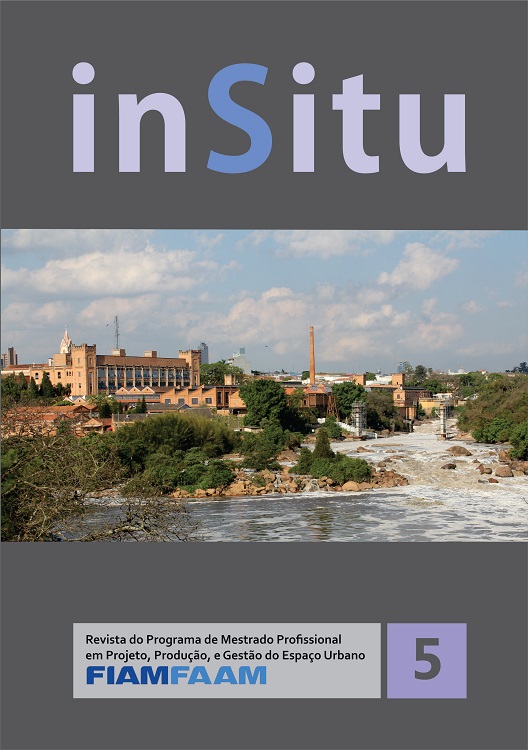A informalidade da favela brasileira: um desenho urbano voltado í moradia social
Palavras-chave:
padrões sociais, favela, moradia de massa, desenho urbano, porosidade urbana.Resumo
Este artigo propõe discutir a habitação social de massa no Brasil. Investiga-se um desenho da moradia social que parte do que existe nas favelas, ou seja, das práticas sociais de dentro das favelas, notoriamente as relações de trabalho em um sistema de circulação econômica contemporâneo. O artigo ensaia uma linguagem arquitetônica que parte das práticas sociais a partir de uma revisão sobre como estas se fundem com a linguagem da arquitetura tradicional, e bem como da discussão da porosidade urbana dentro das favelas (tendo como estudo de caso a Grota do Antigo Telégrafo em Maceió). Pretende-se, assim, humanizar as práticas do arquiteto e experimentar novas formas de abordagem do estudo da moradia de massa no Brasil.
Referências
"A cidade informal no século 21 – Bernardo Secchi" Video Youtube postado por "PMSP Habitação" em 6 de jul de 2010. https://www.youtube.com/watch?v=STeDDmRW8Lo
Alberti, Leon Baptista (1966). L"™architettura de re aedificatoria. Traduzione a cura de Giovanni Orlandi. Milano: Il Polifilo.
Alexander, Cristopher; Ishikawa, Sara;Â Silverstein, Murray;Â Jacobson, Max;Â Angel Shlomo (2013).Uma linguagem de padrões. Porto Alegre: Bookman.
Castells, Manuel, and Géraldine Pflieger (2006). De La Ville Aux Réseaux: Dialogues Avec Manuel Castells. Lausanne: Presses Polytechniques Et Universitaires Romandes.
Cavalcanti, Ana Rosa Chagas (2009). Arquitetura da Carência. Maceió: O jornal.
Cavalcanti, Ana Rosa Chagas (2014). Interview with Royer. Berlin, Weltstad conference.
Cavalcanti, Ana Rosa Chagas (2009). Dos calejados pés, os passos dos filhos de mãe lagoa. A invenção do espaço a partir dos ritos de sururu. Ufal.
Cavalcanti, Ana Rosa Chagas (2015). Pourquoi ne parvenons-nous pas í étudier les favelas comme un authentique système de logement social ? Paris: Autres Brésils.
https://www.autresbresils.net/Pourquoi-ne-parvenons-nous-pas-a-etudier-les-favelas-comme-un-systeme
Hubbard, Phil, Rob Kitchin, and Gill Valentine (2004). Key Thinkers on Space and Place. London: Sage.
IBGE. Brazilian Institute of Statistic and Geography (2013). Habitações subnormais. Brasília: IBGE.
Gehl, Jan (2010). Cities for people. Washington: Island Press.
"2.Formes urbaines et mixité : Historique de l'évolution de la forme urbaine - Jacques Lucan". Video Youtube Publicado por "Club Ville amenagement" em 3 de Setembro de 2012. https://www.youtube.com/watch?v=lg7Cbt9P7Bc
Harvey, David (2012). Rebel Cities: From the Right to the City to the Urban Revolution. New York: Verso.
Jacobs, Jane (1961). The death and life of great American Cities. New York: Vintage Books.
John Turner (1972). Freedom to build. New York: Collier Macmillian.
John Turner (1976). Housing by People. London: Marion Boyars Publishers.
Kenzo Tange (1985). Architecture and the city. Paris: Unesco – The United Nations Educational/Scientific and Cultural Organization.
Le Corbusier (1993). A carta de Atenas. São Paulo: Edusp,.
Lenhen, Johan van (2004). O manual do Arquiteto descalço. Porto Alegre: Livraria do Arquiteto.
Neufer, Ernst; Neufer Peter (2014). A Arte de Projetar em Arquitetura. São Paulo: GG Brasil.
Palladio, Andrea (2014). Â I quattro libri di architettura. A cura di Claudio Pierini. Verona: Cierre Grafica.
Rolnick, Raquel. Lar, doce Lar (a história de uma fórmula arquitetônica). AU. Arquitetura e Urbanismo, São Paulo, v. ano 1, n. 3, 1985.
Roy, Ananya; Alsayyad Nesar (eds). (2003). Urban Informality: Transnational Perspectives from the Middle East, Latin America and South Asia. Oxford: Lexington Books.
"Saskia Sassen - O novo sistema". Fronteiras do pensamento. Video Youtube Publicado por "Fronteiras do pensamento" em 16 de out de 2014. https://www.youtube.com/watch?v=CyrpNj2OQYQ
Santos, Carlos Nelson F. dos. (1988) .A cidade como um jogo de cartas. Niterói: Universidade Federal Fluminense. EDUFF; São Paulo: Projeto.
Secchi, Bernardo (2013). La citta dei ricci e la citta dei poveri. Bari: Gius. Laterza & Figli Spa,.
Sennet, Richard. (2011) Boundaries and Borders. The urban age Project of London School of Economics and Alfred Herhausen Socitey. Living in the Endless city. London:Phaidon.
Sennet, Richard. (2015) The world wants more porous cities so why don"™t we build them. The guardian. Cities. 27th November 2015. Seen in 27th November 2015.
Sousa, Jessé (2011). "A parte de baixo da sociedade brasileira". Revista Interesse Nacional, v.14, p. 33-41.
The urban age Project of London School of Economics and Alfred Herhausen Socitey (2011).. Living in the Endless city. London:Phaidon.
Vitruvio, Marco P. (2007).Tratado de Arquitetura. Tradução do latim de ílvaro Cabral. São Paulo: Martins Editora.
Unesco Courrier.(1985). The urban Explosion. Paris: Unesco – The United Nations Educational/Scientific and Cultural Organization.
Downloads
Publicado
Edição
Seção
Licença
O(s) autor(es) autoriza(m) a publicação do artigo na revista;
O(s) autor(es) garante(m) que a contribuição é original e inédita e que não está em processo de avaliação em outra(s) revista(s);
A revista não se responsabiliza pelas opiniões, ideias e conceitos emitidos nos textos, por serem de inteira responsabilidade de seu(s) autor(es);
É reservado aos editores o direito de proceder ajustes textuais e de adequação do artigos às normas da publicação
Os Autores que publicam nesta revista concordam com os seguintes termos:
- Autores mantêm os direitos autorais e concedem í revista InSitu o direito de primeira publicação, com o trabalho simultaneamente licenciado sob a licença Creative Commons - Atribuição-NãoComercial-CompartilhaIgual 4.0 Internacional. Podem estar disponíveis autorizações adicionais às concedidas no âmbito desta licença em http://www.revistaseletronicas.fiamfaam.br/index.php/situs/about/submissions#copyrightNotice.
- Autores têm autorização para assumir contratos adicionais separadamente, para distribuição não-exclusiva da versão do trabalho publicada nesta revista (ex.: publicar em repositório institucional ou como capítulo de livro), com reconhecimento de autoria e publicação inicial na revista InSitu.
- Autores têm permissão e são estimulados a publicar e distribuir seu trabalho online (ex.: em repositórios institucionais ou na sua página pessoal), já que isso pode gerar alterações produtivas, bem como aumentar o impacto e a citação do trabalho publicado (Veja O Efeito do Acesso Livre).

